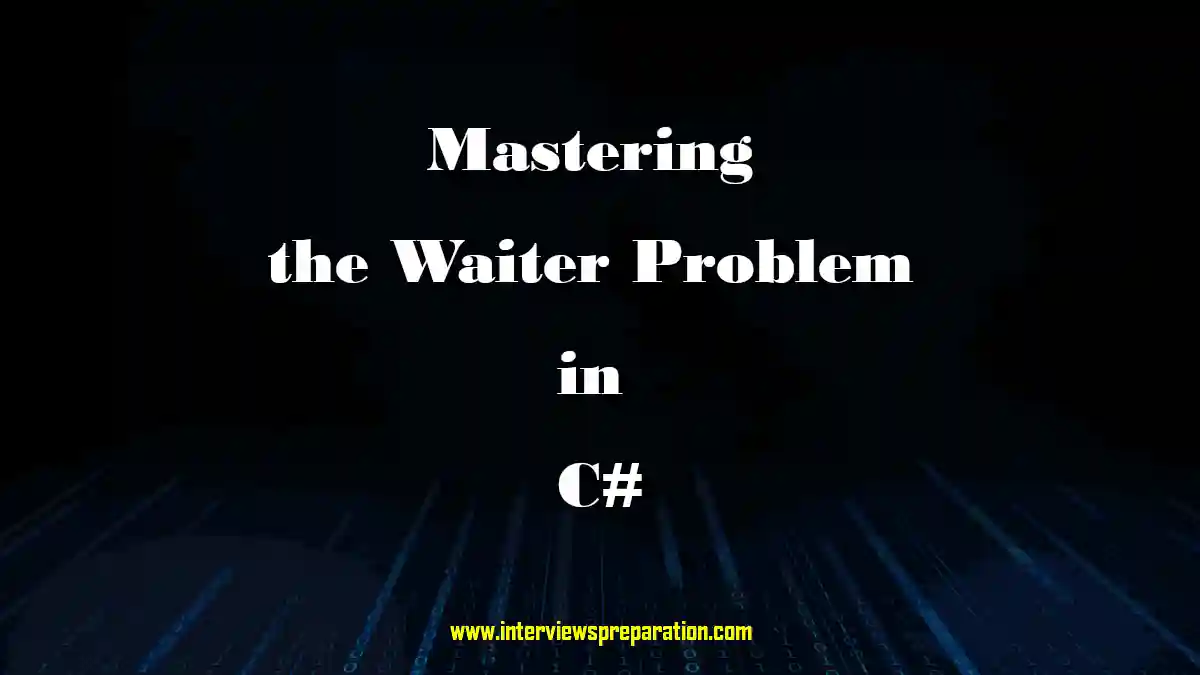In the realm of coding interviews, problem-solving with arrays and stacks is a frequent challenge. One intriguing problem that often surfaces is the “Waiter” problem. This problem tests your understanding of prime numbers, stacks, and iterative processing. Today, we will delve into solving this problem using C# and discuss how it can be a strong component of your interview preparation toolkit.
FREE : If you’re a new visitor preparing for an interview and need help or want to request a new question, you can use the form on the right side to ask your question. It’s free and doesn’t require signing in. Alternatively, you can ask in our Quora space, which is also free, and you’ll receive a response within 24 hours. Go ahead and check it out! do check Master the Stock Span Problem by 3 Easy Steps in Python, Master Abstract Factory Design Pattern for Programming Interviews with 5 easy steps ,Mastering Object-Oriented Programming in C++ , Method Overloading vs. Method Overriding in C#
Table of Contents
Waiter Problem Description
The Waiter problem involves managing a stack of numbered plates and processing them based on prime number divisibility. The goal is to perform a series of operations to reorder the plates and return the final arrangement.
Waiter Problem Breakdown
You start with a stack of plates, each marked with a number. You will use a sequence of prime numbers to determine how to divide and reorder the plates. For each prime number, you check whether each plate’s number is divisible by the prime. Plates that are divisible are moved to a new stack, while those that are not remain in the original stack. After processing with the required number of primes, you collect and return the reordered plates.
Input Format
- An integer n, the number of plates.
- An integer q, the number of iterations or primes to use.
- A list of n integers representing the initial numbers on the plates.
Output Format
A sequence of numbers representing the final order of the plates after all iterations.
Constraints
- The number of iterations q is less than or equal to the number of plates n.
- Each plate number and prime number are positive integers.
Waiter Problem Example
Given the following input:
5 1
3 4 7 6 5After processing with the first prime (2), the output should be:
4
6
3
7
5Waiter Problem Solution Approach in C#
Let’s break down the Waiter Problem Solution using C#:
- Initialize Structures: Use two stacks to manage the plates during each iteration.
- Process Plates: For each prime number, iterate through the stack, check divisibility, and move plates accordingly.
- Output Results: After processing all primes, output the remaining plates in the order they appear.
C# Code Implementation of Waiter Problem
Here’s a step-by-step implementation of the solution in C#:
using System;
using System.Collections.Generic;
using System.Linq;
class Waiter
{
// Function to perform the waiter problem solution
static List<int> ProcessPlates(List<int> plates, List<int> primes)
{
List<int> result = new List<int>();
Stack<int> stack = new Stack<int>(plates);
foreach (int prime in primes)
{
Stack<int> divisible = new Stack<int>();
Stack<int> notDivisible = new Stack<int>();
while (stack.Count > 0)
{
int plate = stack.Pop();
if (plate % prime == 0)
{
divisible.Push(plate);
}
else
{
notDivisible.Push(plate);
}
}
// Push divisible plates to result stack
while (divisible.Count > 0)
{
result.Add(divisible.Pop());
}
// Update stack with not divisible plates
stack = new Stack<int>(notDivisible);
}
// Add any remaining plates to result
while (stack.Count > 0)
{
result.Add(stack.Pop());
}
return result;
}
static void Main(string[] args)
{
// Read input
var input = Console.ReadLine().Split();
int n = int.Parse(input[0]);
int q = int.Parse(input[1]);
var plates = Console.ReadLine().Split().Select(int.Parse).ToList();
// Sample prime numbers for demonstration purposes
List<int> primes = new List<int> { 2, 3, 5, 7 }; // Adjust based on q and actual prime list
// Call the process function
var result = ProcessPlates(plates, primes.Take(q).ToList());
// Output the result
foreach (var plate in result)
{
Console.WriteLine(plate);
}
}
}Explanation of the Waiter Problem C# Code
- Stack Initialization: We use a Stack to manage the plates. This structure helps in efficiently processing plates in LIFO (Last In, First Out) order.
- Processing Loop: For each prime number, we create two stacks: divisible and notDivisible. We then process the original stack and distribute plates into these two stacks based on divisibility.
- Result Construction: After processing each prime, the plates divisible by the prime are added to the result list. Finally, the remaining plates in the stack are also added to the result list.
Summarizing Waiter Problem Solution
Mastering the Waiter problem not only sharpens your problem-solving skills but also prepares you for similar challenges in technical interviews. Understanding how to manipulate stacks and iterate efficiently through a series of operations is key to solving such problems. With practice, you’ll be able to tackle these challenges with confidence.
Happy coding and best of luck with your interviews!
